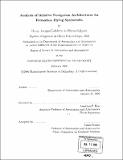| dc.contributor.advisor | Jonathan P. How. | en_US |
| dc.contributor.author | Lefebvre de Plinval-Salgues, Henry Jacques | en_US |
| dc.contributor.other | Massachusetts Institute of Technology. Dept. of Aeronautics and Astronautics. | en_US |
| dc.date.accessioned | 2007-01-10T16:41:26Z | |
| dc.date.available | 2007-01-10T16:41:26Z | |
| dc.date.copyright | 2006 | en_US |
| dc.date.issued | 2006 | en_US |
| dc.identifier.uri | http://hdl.handle.net/1721.1/35575 | |
| dc.description | Thesis (S.M.)--Massachusetts Institute of Technology, Dept. of Aeronautics and Astronautics, 2006. | en_US |
| dc.description | Includes bibliographical references (p. 191-194). | en_US |
| dc.description.abstract | Many future space missions will involve fleets with a large number of satellites flying in formation. Indeed, such fleets provably offer more reliability, redundancy, scalability and repeatability. However, large fleets also represent a challenge, especially for the navigation algorithms, which must provide an accurate estimate of the state of the fleet, with minimum requirements. Furthermore, as the number of satellites in the fleet increases, the computations to be performed increase dramatically, as well as the synchronization and communication requirements, making the design of efficient algorithms a difficult challenge. Based on previous studies, Decentralized Algorithms were designed to spread the computational task. Hierarchic Algorithms were also studied in order to reduce the synchronization requirements. This thesis presents both analytical and numerical comparisons of these algorithms in terms of accuracy, computational complexity, synchronization, and communication. The Decentralized and Hierarchic Algorithms were shown to have good performance in terms of accuracy, while involving far fewer computations than the Centralized Algorithm. As a result, they can be used as scalable algorithms for large formation flying fleets. | en_US |
| dc.description.abstract | (cont.) The thesis investigated two additional problems often associated with navigation filters. The first study considers the problem of processing delayed measurements. Three strategies are analyzed, and compared in terms of the accuracy of the estimate they perform, and the memory and computations they require. One of these approach is shown to be efficient, being accurate without requiring heavy computations nor memory. The second study analyzes a particular instability of the Extended Kalman Filter, encountered when two sensors have very different accuracies. The instability is explained and a method to fix it is proposed. In the example analyzed the method proves to be efficient in addressing the instability. | en_US |
| dc.description.statementofresponsibility | by Henry Jacques Lefebvre de Plinval-Salgues. | en_US |
| dc.format.extent | 194 p. | en_US |
| dc.format.extent | 8032390 bytes | |
| dc.format.extent | 8551946 bytes | |
| dc.format.mimetype | application/pdf | |
| dc.format.mimetype | application/pdf | |
| dc.language.iso | eng | en_US |
| dc.publisher | Massachusetts Institute of Technology | en_US |
| dc.rights | M.I.T. theses are protected by copyright. They may be viewed from this source for any purpose, but reproduction or distribution in any format is prohibited without written permission. See provided URL for inquiries about permission. | en_US |
| dc.rights.uri | http://dspace.mit.edu/handle/1721.1/7582 | |
| dc.subject | Aeronautics and Astronautics. | en_US |
| dc.title | Analysis of relative navigation architectures for formation flying spacecrafts | en_US |
| dc.type | Thesis | en_US |
| dc.description.degree | S.M. | en_US |
| dc.contributor.department | Massachusetts Institute of Technology. Department of Aeronautics and Astronautics | |
| dc.identifier.oclc | 74278487 | en_US |
